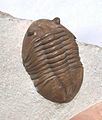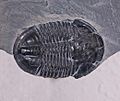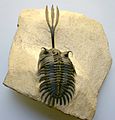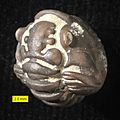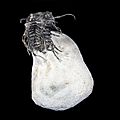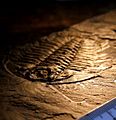Trilobite facts for kids
Quick facts for kids Trilobites |
|
|---|---|
 |
|
| Asaphus kowalewskii | |
| Scientific classification | |
| Kingdom: | |
| Phylum: | |
| Subphylum: |
Arachnomorpha
|
| Class: |
Trilobita
|
Trilobites were amazing ancient creatures that lived in the oceans a very long time ago. Their name means "three-lobed," which describes their unique body shape. These animals were a type of arthropod, like crabs and insects are today.
Trilobites were the first animals we know of that had eyes! They were very common during the early Paleozoic Era, which was hundreds of millions of years ago. You could find them all over the world, but only in salty ocean water. Sadly, all trilobites died out during a huge event called the Permian–Triassic extinction event. This happened about 252 million years ago.
Trilobites had many different ways of living. Some crawled on the seabed, hunting other creatures or eating dead plants and animals. Others were filter feeders, meaning they strained tiny bits of food from the water. Some even swam around, eating tiny floating organisms called plankton. They filled many of the same roles in the ancient oceans that modern marine arthropods do today.
Their bodies were divided into three main parts. The front part was the head, called the cephalon. The middle part was the thorax, which was like their chest. It had up to 30 segments, or sections. The back part was the tail, called the pygidium. Underneath their bodies, which is rarely preserved in fossils, they had many pairs of legs.
Trilobites were truly special because they were the earliest known animals to have vision. The first trilobites had complex compound eyes. These eyes were made of many tiny lenses, just like the eyes of a fly! Their lenses were even made of a mineral called calcite. Some trilobites lived in dark places and had very small eyes, or no eyes at all.
Trilobites came in many sizes. They could be as tiny as 1 millimeter (about the size of a pinhead) or as large as 72 centimeters (almost 2.5 feet!). Most were typically between 3 and 10 centimeters long. The biggest trilobite ever found was named Isotelus rex. Canadian scientists discovered it in 1998 near Hudson Bay.
Trilobites first appeared about 600 million years ago during the Cambrian period. They belonged to the group of animals called Arthropoda. This group includes most of the animal life on Earth today, like crabs, spiders, and insects. Trilobites lived in shallow seas and were very successful. They swam, crawled, and burrowed for about 350 million years! Over this long time, they changed and evolved into many different and interesting shapes.
Discovery
People have been fascinated by trilobites for a very long time. The first discovery by humans happened about 25,000 years ago in France. Two trilobite fossils were found in a Cro-Magnon settlement. One of them even had a hole drilled into it, showing it was worn as jewelry!
Trilobite fossils have also been found in ancient tombs in Egypt, Greece, and Rome. In the 15th century, people in Europe sold trilobite fossils on the street. Even famous American figures like Thomas Jefferson and Benjamin Franklin collected them.
Images for kids
-
A very well-preserved Olenoides serratus from the Burgess Shale, showing its antennae and legs.
See also
 In Spanish: Trilobites para niños
In Spanish: Trilobites para niños



